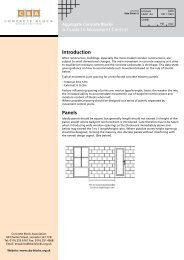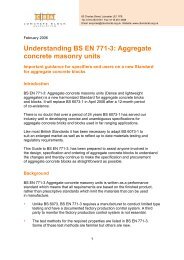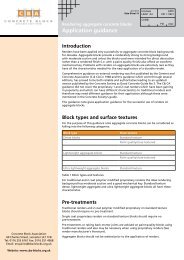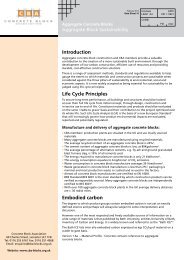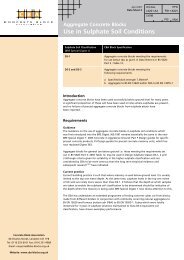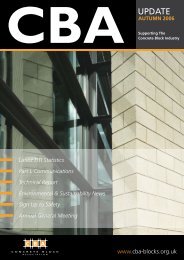Cellular Blocks - Concrete Block Association
Cellular Blocks - Concrete Block Association
Cellular Blocks - Concrete Block Association
You also want an ePaper? Increase the reach of your titles
YUMPU automatically turns print PDFs into web optimized ePapers that Google loves.
April 2007<br />
Data Sheet 14<br />
Uniclass<br />
L3221:A4<br />
EPIC<br />
F611:X221<br />
Aggregate <strong>Concrete</strong> <strong><strong>Block</strong>s</strong><br />
<strong>Cellular</strong> <strong><strong>Block</strong>s</strong><br />
CI/SfB<br />
Ff2<br />
(Ajv)<br />
Introduction<br />
<strong>Cellular</strong> blocks are masonry units that contain one or more formed voids that do not<br />
fully penetrate the block. The selection of cellular blocks can have significant advantages<br />
over solid blocks where weight is a prime consideration. The reduced unit weight makes<br />
for ease of handling, reduced floor/foundation loading, economic and efficient productivity.<br />
They do not require special laying techniques and can be laid on a full bed of standard<br />
1:1:5-6 cement:lime:sand (or equivalent) or general purpose mortar for most applications.<br />
<strong>Block</strong> Specification<br />
In-line voids<br />
Types<br />
There are two block types available in cellular format:<br />
• Dense aggregate blocks (typical material density range 1800 - 2100kg/m³)<br />
• Lightweight aggregate blocks (typical material density range 850 - 1500kg/m³)<br />
Depending on the manufacturer and thickness, cellular blocks may have in-line voids<br />
or parallel voids (multiple rows of voids) – see figures for example of void arrangements.<br />
<strong>Cellular</strong> units with up to and including 25% of formed voids are Group 1 units to<br />
BS EN 1996-1-1. <strong>Cellular</strong> units with greater than 25% of formed cavities are Group 2<br />
units to BS EN1996-1-1.<br />
<strong>Block</strong> with 2 voids<br />
Face sizes/co-ordinating dimensions<br />
<strong>Cellular</strong> aggregate concrete blocks are available in two face sizes (length x height)<br />
of 440 x 215mm and 390 x 190mm.<br />
To obtain the co-ordinating dimensions add the specified joint thickness (normally 10mm)<br />
to the height and length of the block.<br />
<strong>Block</strong> description<br />
<strong>Cellular</strong> blocks are available in various ranges e.g. Standard Common, Close Textured/Paint<br />
Grade Common, Standard, Facing and Architectural Masonry Facing <strong><strong>Block</strong>s</strong>. For more<br />
information see CBA Data Sheet 1 – A Guide to Selection & Specification.<br />
<strong>Block</strong> with 4 voids<br />
Parallel voids<br />
<strong>Block</strong> strengths and dimensions<br />
Strengths<br />
<strong>Cellular</strong> blocks are available in compressive strengths from 2.9N/mm² to 22.5N/mm².<br />
Common strengths are 3.6N/mm² and 7.3N/mm².<br />
Dimensions<br />
<strong>Cellular</strong> blocks are available in widths from 90mm to 215mm in 440 x 215mm<br />
and from 90mm to 190mm in 390 x 190mm face sizes.<br />
<strong>Block</strong> with 2 rows of voids<br />
<strong>Concrete</strong> <strong>Block</strong> <strong>Association</strong><br />
60 Charles Street, Leicester LE1 1FB<br />
Tel: 0116 253 6161 Fax: 0116 251 4568<br />
Email: enquiries@cba-blocks.org.uk<br />
Website: www.cba-blocks.org.uk
<strong>Cellular</strong> <strong><strong>Block</strong>s</strong><br />
Applications<br />
<strong>Cellular</strong> blocks can be used as a direct replacement for solid blocks except where<br />
the most onerous conditions exist such as maximum wall mass for airborne sound<br />
insulation. By selecting the correct specification, cellular blocks can be used in the<br />
following common applications:<br />
• Infill in framed structures<br />
• Providing improved insulation as the inner leaf to external cavity walls<br />
• Outer leaves of cavity walls when protected e.g. render, tiling etc.<br />
• Single leaf external walls when protected e.g. render, tiling etc.<br />
• Internal partitions<br />
• Sound separating walls when supported by acoustic test evidence<br />
• Below dpc internally or externally<br />
Site Considerations<br />
Cutting<br />
<strong><strong>Block</strong>s</strong> containing splitting aids (double thickness central web and/or transverse slot)<br />
are available from most manufacturers in most sizes. Alternatively blocks can be sawn<br />
or split on site taking the appropriate safety precautions or, alternatively, supplied<br />
pre-cut by the manufacturer.<br />
Chasing<br />
Chasing of a cellular block wall can be accommodated. The depth of vertical chasing<br />
should be restricted to not greater than 1/3 block thickness or 1/6 the thickness for<br />
horizontal chases. In addition, the depth of the chase should be restricted to ensure<br />
that a minimum shell thickness of 15mm is maintained between the bottom of the<br />
chase and voids.<br />
Fixings<br />
Standard duty fixings (plastic plug and screw) are easy to install into all types of cellular<br />
blocks and are suitable for most domestic fixing applications (e.g. radiators, kitchen<br />
cupboards, bookshelves etc).<br />
Where heavy duty fixings are required for commercial/industrial applications, standard<br />
bolt type fixings can be used through the solid sections of the block or alternatively,<br />
specialist proprietary fixings can be employed.<br />
Visit www.cba-blocks.org.uk for the latest information, news and views from the CBA.<br />
CBA Technical Helpline 0116 222 1507<br />
© The <strong>Concrete</strong> <strong>Block</strong> <strong>Association</strong> 2007<br />
Although The <strong>Concrete</strong> <strong>Block</strong> <strong>Association</strong> does its best to ensure that any advice,<br />
recommendation or information it may give is accurate, no liability or responsibility of any<br />
kind (including liability for negligence) is accepted in this respect by the <strong>Association</strong>, its<br />
servants or agents.<br />
This datasheet is manufactured from ECF (Elemental Chlorine Free) pulp sourced from<br />
certified or well managed forests and plantations. It is totally recyclable, biodegradable<br />
and acid-free.




